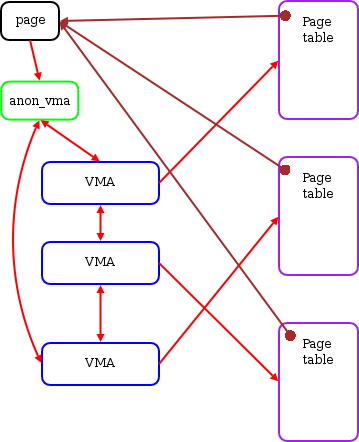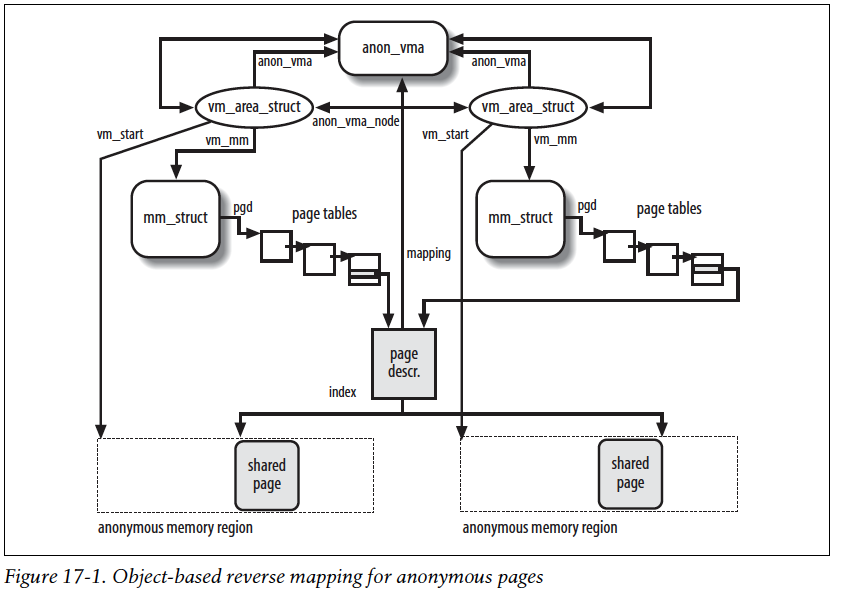Linux Reverse Mapping (rmap)¶
Version History
| Date | Description |
|---|---|
| Jan 6, 2021 | minor update |
| Jun 16, 2019 | add sanitizers section |
Reserve map, or rmap, is a linux data structure used by the memory-management system.
It is a reverse mapping from the physical page back to the PTEs.
More specically, from the struct page back to the list of PTEs that point to the page.
The rmap data structure is used heavily by memory related system calls,
such as mmap, munmap, madvise, brk, and so on.
And it is used by both anonmouys and file-backed pages.
With the help of rmap, kernel is able to identify all the PTEs that point
a certain page. Therefore, when kernel is trying to, say evict the page,
it will be able to clear all the PTEs point to the page.
The rmap data structured is used by both user and kernel pages.
It makes the tracking of page sharing easier.
The rmap concept seems simple and straightforward to implement,
but it is very challenging to design a space- and performance-efficient one.
The linux kernel uses quite a lot of tricks to optimize the rmap.
You will understand how linux rmap works if you read the following articles carefully:
- PDF: Object-based Reverse Mapping
- LWN: Virtual Memory II: the return of objrmap
- LWN: The object-based reverse-mapping VM


Old Notes¶
I implemente the basic PTE-chain based rmap for LegoOS.
I can see the downsides of it. I tried to understand the
linux rmap before, somehow gave up because I couldn’t fully
understand one thing:
for a page that is shared among multiple processes’ VMAs, the source code
suggests it will always have same offset from the beginning of
all VMA (i.e., vm_start). But does it actually works like this
for ALL cases? I just think it’s possible that a page is mapped
by an VMA which has a slightly different starting address.
I still have doubt about it. But after accepting this assumption, it’s just easy to understand. I will check later on.
The code suggests:
- The offset of a page is saved in
page->index. - For anonmouys pages, the
page->indexis saved by page_set_anon_rmap(). - When doing rmap walk over multiple VMAs:
- For anon:
unsigned long address = vma_address(page, vma); - For file:
unsigned long address = vma_address(page, vma); - And
vma_address()is basicallypage->index
static inline unsigned long
__vma_address(struct page *page, struct vm_area_struct *vma)
{
pgoff_t pgoff = page_to_pgoff(page);
return vma->vm_start + ((pgoff - vma->vm_pgoff) << PAGE_SHIFT);
}
Compared to basic PTE-chain based solution, object-based rmap:
The real benefit
- During page fault, we only need to set
page->mappingto point tostruct anon_vma, rather than allocating a new structure and insert.
The downside
- During rmap walk, we need extra computation to walk each VMA’s page table to make sure that the page is actually mapped within this specific VMA.
Adding struct anon_vma is really similar to the idea of reusing address_space,
i.e., having a data structure trampoline.
Some more boring details:
- All pages within a single VMA share just one
anon_vma.vma->anon_vmaindicates if a VMA has attached or note. Related function isanon_vma_prepare()withindo_anonymous_fault()link.
